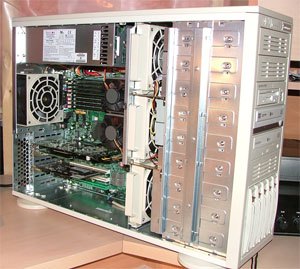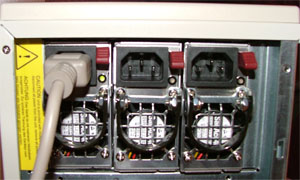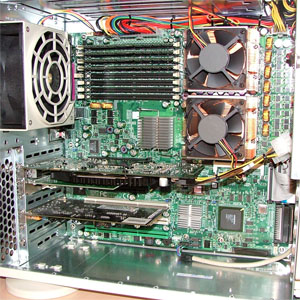The New Powerhouse
Chassis
The 7044A-82R is a mid-tower system that is targeted at the workstation/server market. Its case design and feature-set could definitely put it in either market, with a strong emphasis on the server market due to its redundant power, rack-mount option, and hot swappable hard drive cage. The case itself has a triple redundant 760 Watt power supply, hot swappable cooling fans and a flexible drive bay configuration. Our unit was equipped with 5 hot swap drive bays, but the system can handle 10 hot swap bays with a stackable drive cage mounted in the front of the case (see image below).

Click to enlarge.

Click to enlarge.

Click to enlarge.
Motherboard & CPU
The heart of our new workstation is a
Supermicro X6DA8-G2, outfitted with Dual 3.6 GHz, 800MHz FSB Nocona CPUs. The X6DA8-G2 is one of the latest boards from Supermicro for Intel's new Nocona CPUs. This particular board uses Intel's E7525 Tumwater chipset and has the following features:
- 16GB DDR2-400 SDRAM (our system arrived with 4 512MB Infineon sticks)
- Intel Dual Gigabit Network interfaces
- Adaptec Dual U320 SCSI (AIC-7902)
- Dual SATA ports (ICH5R)
- 1 (x16) PCI-Express slot
- 1 (x4) using (x16 slot) PCI-Express
- 1 x 64Bit 133Mhz bit PCI-X
- 2 x 64bit 100 Mhz PCI-X
- 1 32bit PCI slots
- Zero channel raid support (allows you to buy an Adaptec 2010S to add raid support)
- AC'97 6-channel sound
This is a well-equipped board, and has room for storage expansion with zero channel raid support and flexible chassis configuration support.

Click to enlarge.
Graphics Card
Since our system was built as a workstation, it was outfitted with a NVidia Quadro FX 3400. Granted, this card is overkill for my purpose, but it does have Dual DVI and is ready for SLI with another 3400 if the need for more power is ever required. The Tumwater chipset is currently the only chipset that will support operating NVidia's Quadro or 6800 based cards in SLI. The Quadro FX managed to maintain 60+ fps at 1024 x 768 high quality in Doom 3 when I wasn't busy writing code.
I/O
Since compiling is very I/O intensive, we put two Seagate 18GB U320 15,000RPM drives in the system. We'll probably get larger drives in the future, but for now, it's enough space for the OS and the site code, with some room left over for the odd game or two.














21 Comments
View All Comments
JasonClark - Friday, September 10, 2004 - link
mikepeck, it certainly is overkill, we're speed nuts like the rest of you. Compile time for building isn't much at all, but compile time after a change (as .NET re-compiles all of the files) does take some time. As said in the article the opteron did just fine, but 7200 RPM IDE drives aren't all that quick during heavy compilation. This article was more information, not a benchmark or comparison between opteron/nocona as a workstation.We are interested in doing some real workstation benchmarks, but need some input as to what people would like to see.
mikepeck - Friday, September 10, 2004 - link
Wow. This is what happens when you have a hardware nut from a hardware site put together a "workstation". Also, not sure how a measly dual opteron wouldn't hack it. How long of compiles are you talking about here? I've done serious .NET development on systems FAR less than what you speak of. Perhaps it is a bit of jealousy, but for a .NET development machine, ya, just a BIT of an overkill.Booty - Friday, September 10, 2004 - link
I know this is a bit off topic, but I've looked around for some good how-to's for building your own high-end workstations and/or servers, and haven't found much. There's tons of info out there about building your own PC, but not much for servers. Hell, I wouldn't even know where to go to buy the hardware - Newegg doesn't seem to carry much server stuff.Say I wanted to build the equivalent of a Dell PowerEdge 6600... anyone know of any good resources for someone wanting to get into that type of thing?
JasonClark - Friday, September 10, 2004 - link
One thing this article brings up is the need for workstation articles. If any of you are interested, what benchmarks would you like to see, besides compiling.JasonClark - Friday, September 10, 2004 - link
Ryan, we keep most of the hardware we test around the labs for future articles/comparisons. Spare is a term to be used lightly in the lab, until its needed :).RyanVM - Friday, September 10, 2004 - link
You know, if dual Opteron 246s, 1GB memory, and a 120GB SATA hard drive are "spare parts", I want to rummage through you guys' junk pile! :PPrinceGaz - Friday, September 10, 2004 - link
I was under the impression that AMD K8 processors (Opteron, Athlon 64) are considerably faster than than Intel's best Pentium 4's for compiling. Given that a 3.6GHz Nocona is to all intents and purposes a P4 560, with 64-bit support which Windows Server 2003 does not use, and an Opteron 250 is equivalent to an Athlon64 FX53 (S940); the 3.6GHz Nocona is a long way behind the Opteron 250 in the Visual Studio compile test.http://www.anandtech.com/cpuchipsets/showdoc.aspx?...
That gap will almost certainly widen in a dual-processor system.
JasonClark - Friday, September 10, 2004 - link
Exmaster76, you'll see an article very shortly about Opteron 250 vs Nocona 3.6..Cheers
JasonClark - Friday, September 10, 2004 - link
daniel, I had a look at that app as well, not bad but I wanted everything running at the same time as some sites depend on others.Cheers
daniel1113 - Friday, September 10, 2004 - link
I've got one word for any web developers out there that use Windows XP Pro rather than a server OS:IISAdmin
It allows you to easily switch between websites in IIS. Of course, you are still limited to one website at a time, but if you work on multiple sites on your home computer, this little program works wonders.